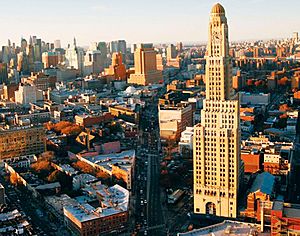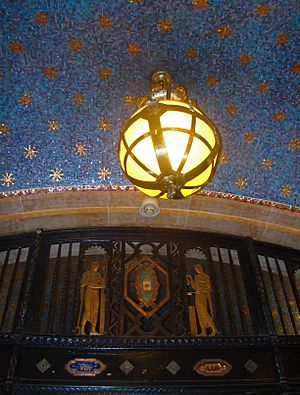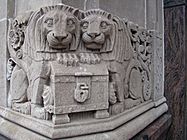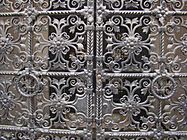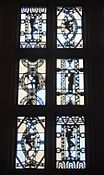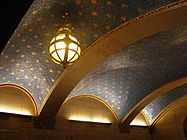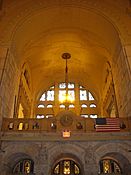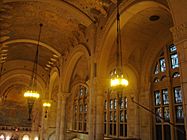Williamsburgh Savings Bank Tower facts for kids
Quick facts for kids Williamsburgh Savings Bank Tower |
|
|---|---|
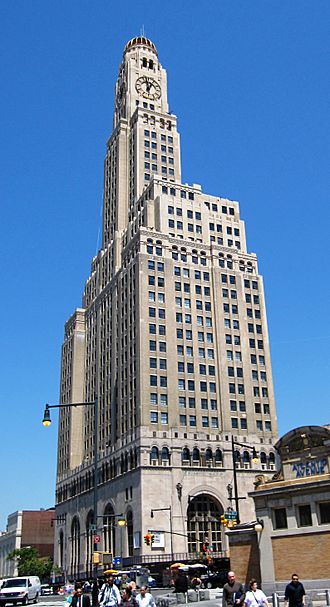
Williamsburgh Savings Bank Tower (2010)
|
|
| Alternative names | 1 Hanson Place |
| General information | |
| Status | Complete |
| Type | Residential |
| Architectural style | Neo-Romanesque |
| Address | 1 Hanson Place Brooklyn, New York 11243 |
| Coordinates | 40°41′8″N 73°58′40″W / 40.68556°N 73.97778°W |
| Construction started | 1927 |
| Opened | April 1, 1929 |
| Renovated | 2006–2007 |
| Height | |
| Roof | 512 feet (156 m) |
| Technical details | |
| Floor count | 37 |
| Design and construction | |
| Architect | Halsey, McCormack and Helmer |
| Renovating team | |
| Renovating firm | H. Thomas O’Hara |
The Williamsburgh Savings Bank Tower is a very tall building, also known as 1 Hanson Place. It stands in Downtown Brooklyn, New York City. This amazing tower was built between 1927 and 1929. It was designed by the architects Halsey, McCormack and Helmer. The building was originally the main office for the Williamsburgh Savings Bank.
For many years, this tower was the tallest building in Brooklyn. It has 37 floors and reaches 512 feet (156 meters) into the sky. It is also famous for having one of the tallest four-sided clock towers in the world. Each clock face is huge, about 17 feet across! In 1994, the New York City Landmarks Preservation Commission made the tower an official city landmark. This means it is a special building that must be protected. Since 2007, the tower has been changed into fancy apartments.
Contents
Where is the Tower?
The Williamsburgh Savings Bank Tower is at 1 Hanson Place. It's located near a busy area called Times Plaza. This area is where several big streets meet, like Atlantic, Flatbush, and Fourth Avenues. You can also find the Atlantic Terminal mall and the Barclays Center nearby.
Even though it's called "Williamsburgh," the tower is not in the Williamsburg neighborhood. Instead, it's in the Fort Greene and Pacific Park parts of Brooklyn. The bank's first building, which was also very grand, is still in Williamsburg.
Amazing Design
The Williamsburgh Savings Bank Tower has a special design style. It mixes old Byzantine and Romanesque looks with modern touches. The top of the tower has a shiny copper dome that looks like gold. You can also see cool carvings of lions, turtles, and birds on the outside walls.
Inside, the main banking hall is truly amazing. It has high, arched ceilings that are 63 feet tall. There are also huge windows, 40 feet high, and beautiful mosaics. The building even had two public viewing areas where you could learn about the Battle of Brooklyn.
What it Looks Like
The architects planned a new building without a dome at first. However, the bank really wanted a dome. They felt it was their special symbol, just like on their original building. One of the architects, Helmer, said he wanted the building to feel like a "cathedral." He hoped it would inspire people to save money and be successful.
Outside Details
The outside of the building has a smooth, shiny granite wall at the bottom. It's at shoulder height for people walking by. There's a special message carved into the stone near a corner. It talks about the people who saved money at the bank. It says their hard work helped them build homes and educate children. It also says they gained independence and dignity through saving.
Look closely at the carvings around the windows. They tell a story about saving money! You can see beehives and squirrels, which store things for later. There's also the head of Mercury, who was the god of business. Wise owls and strong lions are also carved there. The lions' paws protect the bank's lockbox. You might even spot a carving of a burglar. This was to show depositors that their money was safe inside the bank's huge vault.
Inside the Tower
Main Hall
When you enter, you walk through a small entrance area. The ceiling here is covered in beautiful mosaics with colors from gray-blue to bright turquoise. The glass doors leading to the main banking hall are decorated with fancy metalwork. These metal screens were made by an artist named René Chambellan. They show pictures of different jobs, like artisans working.
The main banking hall is very large, about 63 feet high and 128 feet long. It has walls made of limestone and marble. The huge, tinted windows have metal cutouts showing workers and students. The hall has a central walkway with columns on either side. The ceilings sparkle with gold mosaics and tiny stars that show the constellations of the Zodiac. The floor is also decorated with colorful marble designs. At one end, a giant mosaic shows a view of Breuckelen (an old name for Brooklyn). You can see Manhattan in the distance and the Williamsburgh Savings Bank Tower lit up by sunlight.
Other Areas
Above the main hall, there were two floors of bank offices. The rest of the building had offices that the bank rented out to other businesses. From 2006 to 2007, these office spaces were changed into 176 apartments. These apartments have many different layouts, from small studios to very large four-bedroom homes.
In the basement, there were huge vault doors. Each door weighed 60 tons! These vaults kept the bank's money safe.
Tower History
The Williamsburgh Savings Bank Tower was built from 1927 to 1929. It was designed by the architectural firm Halsey, McCormack and Helmer. After the Williamsburgh Savings Bank, the building was owned by other banks, like Republic National Bank and then HSBC. HSBC later moved to a new building nearby.
For many years, the offices in the tower were mostly for dentists. People even called it "The Mecca of Dentistry" because so many dentists worked there.
The outside of the building was made a New York City landmark in 1977. Later, in 1996, the inside of the building also became a landmark. This means that special care must be taken to keep the building looking the way it was designed.
In 2005, a company called Skylight Studios One Hanson worked with Canyon Capital Realty Advisers. They started a big project to change the old bank building. During this project, they made sure to keep the beautiful marble floors, carved teller stations, and the amazing vaulted ceiling. They also protected the 40-foot mosaic of New York as a Dutch colony. Around the same time, Magic Johnson helped turn the building into 176 luxury apartments between 2006 and 2007. In 2008, CJ Follini and Noyack Medical Partners bought the commercial parts of the landmark building.
Gallery
See also
 In Spanish: Williamsburgh Savings Bank Tower para niños
In Spanish: Williamsburgh Savings Bank Tower para niños


